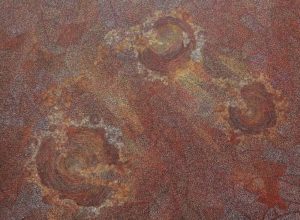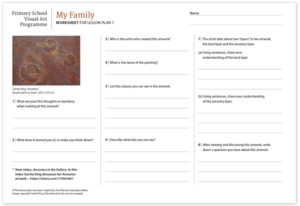
Activity 7
Ancestors Artwork Response (2 Sessions)
This activity provides an opportunity for students to consider and respond to an artist’s artwork, to build their knowledge but also consider an artist’s viewpoint and how they communicate this through visual conventions.
Curriculum
Western Australian Curriculum Content Descriptions
Appreciation and respect for a range of artworks from different social, cultural and historical contexts.
Responses to their own and others’ artwork, reflecting on meaning using visual art terminology.
Australian Curriculum Version 8.3 Content Descriptions
Identify intended purposes and meanings of artworks, using visual arts terminology to compare artworks, starting with visual artworks in Australia including visual artworks of Aboriginal and Torres Strait Islander Peoples (ACAVAR113).
Materials
Worksheet for Lesson Plan 7: Ancestors.
Coloured images of Sarrita King’s Ancestors for students to view in pairs. Download: Ancestors (JPG)
Writing equipment such as pencils, erasers, sharpeners, textas.
Technology to share Sarrita King’s video discussing Ancestors, https://vimeo.com/175924467
Activity
Display image of Sarrita King’s Ancestors. For this example the artwork’s image was viewed on the classroom’s digital whiteboard.
Before students view the image, invite them to be conscious of their first thoughts/reactions/feelings when viewing the image displayed.
Students view the image silently for a few minutes.
Still in silence, hand out laminated copies of the image and organise students into pairs.
Ask students to share with their partner their first thoughts or reactions when looking at the displayed image. Students take turns sharing their initial reaction to the image.
Ask students to think about what the image reminds them of. Then, after a few minutes, ask students to share this with their partner.
As a class, students share their responses.
Introduce Sarrita King as the artist who created the image displayed. Share some information about Sarrita King – https://japingkaaboriginalart.com/artists/#sarrita. For example, “Sarrita King was born in Adelaide in 1988, the younger sister of fellow artist Tarisse King, and daughter of the highly regarded late artist, William King Jungala (1966–2007). Sarrita King inherits her Australian Aboriginality from her father, a Gurindji man from the Northern Territory. Sarrita grew up in Darwin in the Northern Territory, where her connections to her Aboriginality and her land were nurtured. Stylistically, Sarrita uses traditional Aboriginal techniques and iconography, but she incorporates along with them unorthodox techniques inherited from her father, as well as techniques she has developed through her own practice. Sarrita now lives and paints in Darwin. She has been included in over twenty exhibitions, is represented in galleries in all Australian states, and in many high profile Australian and international art collections.”
Display Worksheet for Activity 7: Ancestors.
Read/explain Questions 1 and 2. Remind students they have already shared their responses to these questions with their partner. Question 1 asks their first thoughts and reactions, while Question 2 asks what the image reminded them of, or made them think about. Students record their responses through answering Question 1 and 2.
The following are some examples of Year 4 student responses to these questions.
Question 1
“What is that? It looks cool.”
“It looks like a farm, lots of roads and mazes.”
“Whoa, I am amazed, wouldn’t this take a long time? It’s like Aboriginals rock art back in those years.”
“The artwork is a sort of aboriginal map of waterholes and roads.” “Art can look weird.”
Question 2
“The desert with rivers and people threw a rock into a whirlpool.” “Caves, museums, tornadoes, shells and Aboriginals.”
“It reminds me of Quinninup Falls because in a part of the track there is a red brown dirt in the pattern of this.”
“A maze you never get through.”
“It reminded me of tree trunks and fossils. It reminded me of a maze.”
“It reminds me of a lot of roads in the middle of nowhere and it looks like a lot of shattered glass and the swirls look like a finger print that has been maximised.”
View video, Ancestors in the Gallery. In this video Sarrita King discusses her Ancestor artwork – https://vimeo.com/175924467
Ask students to answer Question 3 and 4. Remind students that the information about the artwork is under the image on the worksheet. In an art gallery it may be on a label next to the artwork on a wall. In a book it is usually on the same page as the artwork. Students complete Questions 3 and 4.
Read out Question 5 to the class. Refer to students’ colour mixing lessons and discuss ways to describe colours. For example, using standard names for paint colours such as ochre and blue, and using descriptive words such as such as dark/light or warm/cool, etc. Students complete Question 5.
Read and explain Question 6 to the class. Students complete Question 6.
Re-watch video Ancestors in the Gallery. Assist students’ viewing by pausing and discussing Sarrita’s commentary. This will be dependent on students’ prior knowledge and experience. For this shared example, the video was paused at the following times:
• 0:15 – explanation of foreground and background • 0:20 – explanation of the term “ancestry”
• 0:30 – explanation of wet season/dry season
• 1:06 – Think, Pair, Share
• 1:31 – explanation of ancestry layer.
Read and discuss Questions 7 and 8. Students complete Questions 7 and 8.
The following are some examples of Year 4 student responses to these questions.
Question 7
“That these layers... she is using two layers, they are... ancestor layer is moving through and out the lines as if she was trying to describe her family and that we are all different. As for the land layer is describing that all ancestors went straight through the waterhole (land layer) which is not a land with trees and water it's hot like a desert, in fact, it was the dry season there is also a wet season but they did empty the waterhole then you could see them running away from the waterhole and from the animal tracks. It's about her ancestors walking on this land very well before all of us.”
“She said that her land layer was about ancestors walking around near those colours and she said it was the dry season that it was a waterhole drying up and the animal tracks running away. And the ancestry layer was reflecting that her ancestors were walking on the land before us.”
Question 8
“Why are there so many twists and turns? Why do these look like giant finger prints? I wonder why they only use a certain amount of colours? Do layers really help you sort out your painting?”
“What else could this artwork remind Sarrita King about?”
“How long did it take to paint it and did she try and get the land painted with a bird’s eye of view?”
Teacher Notes
For written tasks, support students with weaker literacy by scribing their oral response.
As an alternative, rather than a written analysis worksheet for students, teachers could ask students to respond to three prompts: I see... I wonder... I think... or use Visual Thinking Strategies questions such as “What’s going on in this picture?” “What do you see that makes you say that?” “What more can you find?”
Time
For this documented project, Year 4 students required one 50-minute lesson.
© This lesson plan has been created by Ana Nail and Japingka Gallery. Educational study use encouraged.
Overview | Lesson 1 | Lesson 2 | Lesson 3 | Lesson 4 | Lesson 5 | Lesson 6 | Lesson 7 | Lesson 8 | Lesson 9 | Lesson 10 | Lesson 11 | Lesson 12 | Lesson 13


